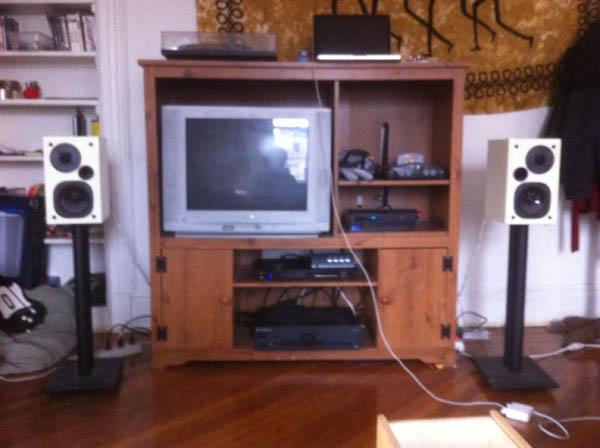| Columns Retired Columns & Blogs |
Please tell me that's an Ocarina of Time cartridge in the N64

First on the Rega P1 was Mercedes Sosa’s Homenaje a Violeta Parra. I closed my eyes and focused on the sound. Mercedes Sosa’s towering delivery resounded hugely over a precisely strummed nylon-string guitar and thumping tribal drums. Sound in the new room was phenomenal. I had never before experienced such soundstage depth with my system.
Drums were articulate and big without unevenness. The bass bloat was gone. Totally totally gone. Maybe too gone.
Yet, Mercedes Sosa and her guitar were both left of center. They should line up in the middle. My speakers were equidistant on all sides from walls and furniture. Early sidewall reflections did not cause of the imbalance in my previous listening room. The problem was my gear.
I listened to more records and developed a hunch. The sandpaper roughness in the attack on the snare on Rhye's Woman gave it away.
I sent JA the following email:
“i think there might be something wrong with the tweeter on my right speaker.
the left speaker's highs seem to be a little crisper/a little tighter/a little more defined.
could you recommend a good way to confirm this?
While waiting for JA’s response, I called in new roommate Matt. Matt replaced Pete. Pete moved out after he discovered the hi-fi was moving in next door. Matt panned the speakers from left to right as I listened. Then I panned the speakers for Matt. When asked if he heard a difference, he said, “I think the left speaker seems a little louder.”
“Yeah,” I agreed.
In that time, JA responded:
Connect one of the speakers out of phase and place the pair face to face, with about 1" between them. Play the pink noise track. If the speakers match, the sound will almost completely cancel. But if it doesn't, the affected region will still produce sound.
I switched the ends of my speaker cable on the back of the right speaker. The amp's right negative “black” output terminal now communicated with the positive “red” input terminal on my speaker, and the amp's right positive “red” output terminal now communicated with the negative “black” input terminal of my speaker. I placed my Ushers 1" apart face to face on stands and played Track 18 on Stereophile’s Editor’s Choice “Dual Mono Pink Noise”. A fast helicopter whirring and chirping emitted from my right speaker’s tweeter.
As a final test, I plugged my speakers back in phase, and ran Track 23 from Editor’s Choice “Treble Decade 1/3-octave warble tones at -20dBFS”. The soundstage was massively imbalanced towards the left from 8khz and upwards.
Four years ago, an old band mate and I took a stab at an experimental noise collage. It concluded with an incredibly high-pitched volume swell from my Casio. We let the organ clip into the red for “dramatic effect.” Weeks later, I noticed my right speaker started crackling. I did not work for Stereophile at the time. I thought nothing of it.

Use one channel to drive both speakers, reversing the phase of one of the speakers. This way there's absolutely no difference in the driving signal from the amplifier, so you eliminate that as a variable.